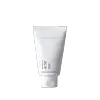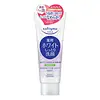What's inside
What's inside
 Key Ingredients
Key Ingredients

No key ingredients
 Benefits
Benefits

 Concerns
Concerns

 Ingredients Side-by-side
Ingredients Side-by-side

Water
Skin ConditioningCocamidopropyl Betaine
CleansingSodium Methyl Oleoyl Taurate
CleansingPEG-75
HumectantAcrylates Copolymer
Glycerin
HumectantDisodium Cocoamphodipropionate
CleansingPEG-120 Methyl Glucose Dioleate
EmulsifyingDimethyl Sulfone
SolventPyridoxine Hcl
Skin ConditioningSalix Alba Bark Extract
AstringentForsythia Suspensa Fruit Extract
AntioxidantButylene Glycol
HumectantCentella Asiatica Extract
CleansingPolygonum Cuspidatum Root Extract
AntioxidantScutellaria Baicalensis Root Extract
AstringentCamellia Sinensis Leaf Extract
AntimicrobialGlycyrrhiza Uralensis Root Extract
Skin ConditioningChamomilla Recutita Flower Extract
MaskingRosmarinus Officinalis Leaf Extract
AntimicrobialSodium Chloride
MaskingCopper Tripeptide-1
Skin ConditioningAllantoin
Skin ConditioningCitric Acid
BufferingPotassium Hydroxide
BufferingSodium Benzoate
MaskingPhenoxyethanol
PreservativeDisodium EDTA
Water, Cocamidopropyl Betaine, Sodium Methyl Oleoyl Taurate, PEG-75, Acrylates Copolymer, Glycerin, Disodium Cocoamphodipropionate, PEG-120 Methyl Glucose Dioleate, Dimethyl Sulfone, Pyridoxine Hcl, Salix Alba Bark Extract, Forsythia Suspensa Fruit Extract, Butylene Glycol, Centella Asiatica Extract, Polygonum Cuspidatum Root Extract, Scutellaria Baicalensis Root Extract, Camellia Sinensis Leaf Extract, Glycyrrhiza Uralensis Root Extract, Chamomilla Recutita Flower Extract, Rosmarinus Officinalis Leaf Extract, Sodium Chloride, Copper Tripeptide-1, Allantoin, Citric Acid, Potassium Hydroxide, Sodium Benzoate, Phenoxyethanol, Disodium EDTA
Dipotassium Glycyrrhizate
HumectantMyristic Acid
CleansingGlycerin
HumectantStearic Acid
CleansingPotassium Hydroxide
BufferingLauric Acid
CleansingPEG-7 Glyceryl Cocoate
EmulsifyingPPG-7 Lauryl Ether
EmollientSulfuric Acid
BufferingMilk Ferment
Skin ConditioningButylene Glycol
HumectantSodium Lauroyl Glutamate
Lauroyl Lysine
Skin ConditioningSilk Powder
Skin ConditioningGlycol Stearate
EmollientHydroxypropyl Methylcellulose
Emulsion StabilisingSodium Lauroyl Ethylenediamine Triacetate
Glyceryl Isostearate
EmollientAlcohol
AntimicrobialEthylparaben
PreservativeMethylparaben
PreservativeDipotassium Glycyrrhizate, Myristic Acid, Glycerin, Stearic Acid, Potassium Hydroxide, Lauric Acid, PEG-7 Glyceryl Cocoate, PPG-7 Lauryl Ether, Sulfuric Acid, Milk Ferment, Butylene Glycol, Sodium Lauroyl Glutamate, Lauroyl Lysine, Silk Powder, Glycol Stearate, Hydroxypropyl Methylcellulose, Sodium Lauroyl Ethylenediamine Triacetate, Glyceryl Isostearate, Alcohol, Ethylparaben, Methylparaben
 Reviews
Reviews

Ingredients Explained
These ingredients are found in both products.
Ingredients higher up in an ingredient list are typically present in a larger amount.
Butylene Glycol (or BG) is used within cosmetic products for a few different reasons:
Overall, Butylene Glycol is a safe and well-rounded ingredient that works well with other ingredients.
Though this ingredient works well with most skin types, some people with sensitive skin may experience a reaction such as allergic rashes, closed comedones, or itchiness.
Learn more about Butylene GlycolGlycerin is already naturally found in your skin. It helps moisturize and protect your skin.
A study from 2016 found glycerin to be more effective as a humectant than AHAs and hyaluronic acid.
As a humectant, it helps the skin stay hydrated by pulling moisture to your skin. The low molecular weight of glycerin allows it to pull moisture into the deeper layers of your skin.
Hydrated skin improves your skin barrier; Your skin barrier helps protect against irritants and bacteria.
Glycerin has also been found to have antimicrobial and antiviral properties. Due to these properties, glycerin is often used in wound and burn treatments.
In cosmetics, glycerin is usually derived from plants such as soybean or palm. However, it can also be sourced from animals, such as tallow or animal fat.
This ingredient is organic, colorless, odorless, and non-toxic.
Glycerin is the name for this ingredient in American English. British English uses Glycerol/Glycerine.
Learn more about GlycerinPotassium hydroxide is commonly known as caustic potash. It is used to fix the pH of a product or as a cleaning agent in soap. In cleansers, it is used for the saponification of oils.
Sapnification is the process of creating fatty acid metal salts from triglycerides and a strong base. During this process, Potassium Hydroxide is used up and is not present in the final product.
Using high concentrations of Potassium Hydroxide have shown to irritate the skin.
Learn more about Potassium Hydroxide